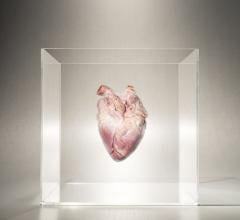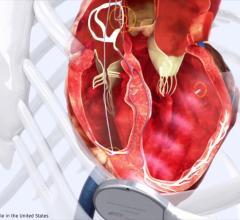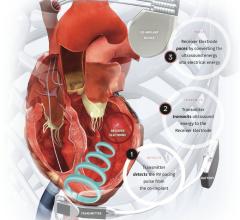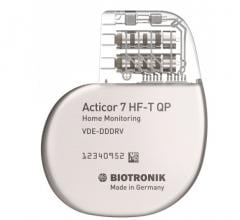
Image courtesy of Impulse Dynamics
May 18, 2018 — In a new study, cardiac contractility modulation (CCM) therapy was confirmed to significantly improve exercise tolerance (ET) and quality of life (QoL) for patients with persistent symptomatic heart failure and an ejection fraction between 25 and 45 percent. Results of the prospective FIX-HF-5C Study were presented at the 2018 Heart Rhythm Society (HRS) Scientific Sessions, May 9-12 in Boston.
CCM therapy for patients with persistent symptomatic heart failure (NYHA Class III and IV) consists of nonexcitatory electrical signals delivered to the heart during the absolute refractory period. The objective of the prospective FIX-HF-5C study was to confirm a subgroup analysis of a prior study (FIX- HF-5) showing that CCM significantly improved ET and QoL in the target patient group.
One hundred and sixty patients were randomized to continued medical therapy alone (Control) or to continued medical therapy plus CCM delivered by Impulse Dynamics’ Optimizer system (Treatment) for 24 weeks. All patients had NYHA III or IV symptoms despite guideline recommended therapy, QRS duration <130ms and LVEF 25-45 percent. Peak VO2 (pVO2, primary endpoint), Minnesota Living with Heart Failure Questionnaire (MLWHFQ), NYHA and six-minute hall walk (6MHW) test were measured at baseline, 12 and 24 weeks. Bayesian repeated measures linear modeling was used for the primary endpoint analysis, with 30 percent borrowing from the FIX-HF-5 subgroup. Safety was assessed by the percentage of patients free of device-related adverse events, with a prespecified lower bound of 70 percent.
The difference in pVO2 between Treatment and Control was 0.836 mlO2/kg/min with a 95 percent Bayesian credible interval of (0.123, 1.552 mlO2/kg/min), satisfying the primary endpoint. MLWHFQ (p<0.001), NYHA (p<0.001) and 6MHW (p=0.01) were all better in Treatment vs Control. There were seven device-related events, yielding a lower bound of 80% of patients free of events.
For more information: www.hrssessions.org
Related HRS Content
Heart Rhythm 2018 Late-breaking Studies
Long-Term Data Demonstrate Safety, Efficacy of Optimizer System


 April 25, 2025
April 25, 2025 








